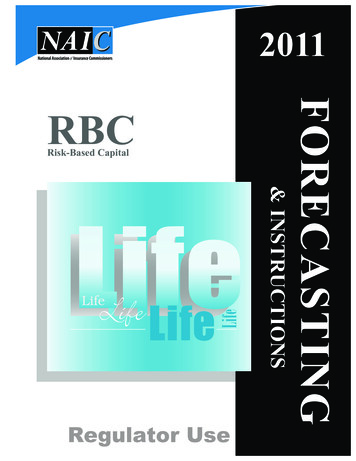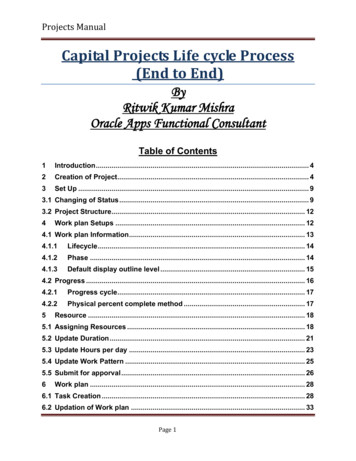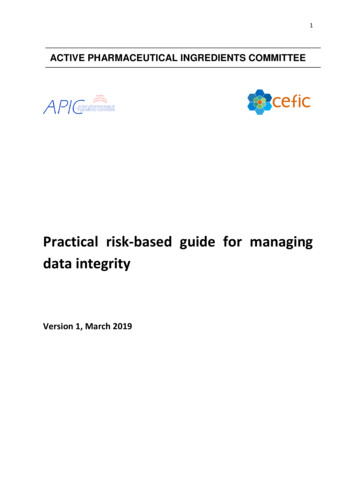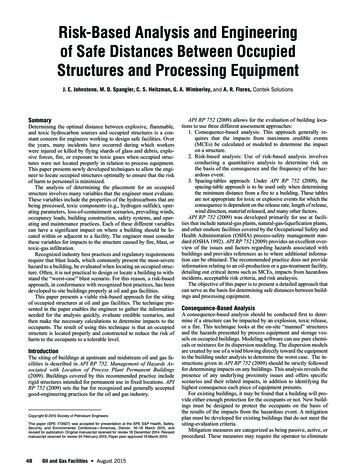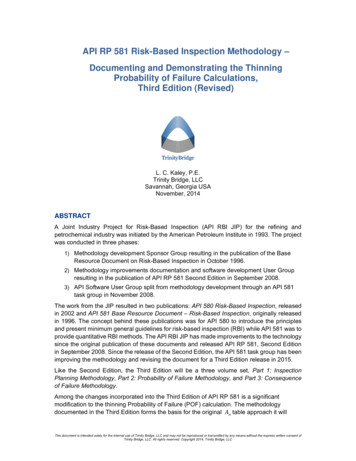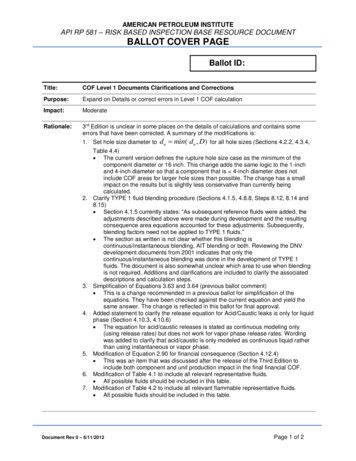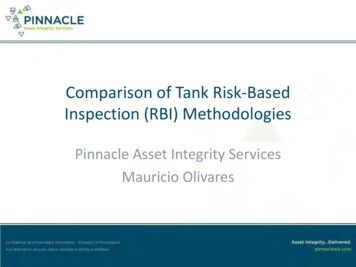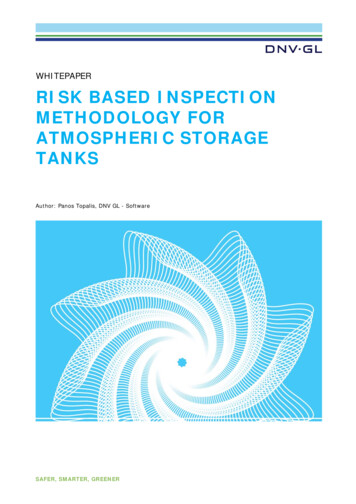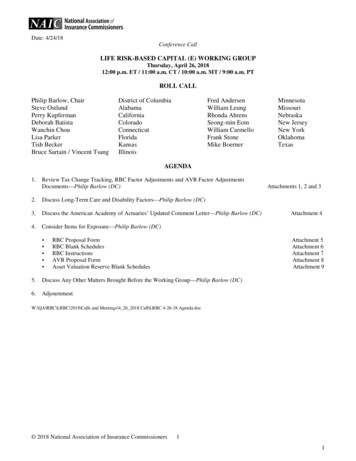
Transcription
Date: 4/24/18Conference CallLIFE RISK-BASED CAPITAL (E) WORKING GROUPThursday, April 26, 201812:00 p.m. ET / 11:00 a.m. CT / 10:00 a.m. MT / 9:00 a.m. PTROLL CALLPhilip Barlow, ChairSteve OstlundPerry KupfermanDeborah BatistaWanchin ChouLisa ParkerTish BeckerBruce Sartain / Vincent TsangDistrict of aKansasIllinoisFred AndersenWilliam LeungRhonda AhrensSeong-min EomWilliam CarmelloFrank StoneMike BoernerMinnesotaMissouriNebraskaNew JerseyNew YorkOklahomaTexasAGENDA1.Review Tax Change Tracking, RBC Factor Adjustments and AVR Factor AdjustmentsDocuments—Philip Barlow (DC)2.Discuss Long-Term Care and Disability Factors—Philip Barlow (DC)3.Discuss the American Academy of Actuaries’ Updated Comment Letter—Philip Barlow (DC)4.Consider Items for Exposure—Philip Barlow (DC) RBC Proposal FormRBC Blank SchedulesRBC InstructionsAVR Proposal FormAsset Valuation Reserve Blank SchedulesAttachments 1, 2 and 3Attachment 4Attachment 5Attachment 6Attachment 7Attachment 8Attachment 95.Discuss Any Other Matters Brought Before the Working Group—Philip Barlow (DC)6.AdjournmentW:\QA\RBC\LRBC\2018\Calls and Meetings\4 26 2018 Call\LRBC 4-26-18 Agenda.doc 2018 National Association of Insurance Commissioners11
This page intentionally left blank.2
CategoryCurrent Pre-TaxFactorCurrentTaxFactorLife Practice Council RBC Tax Reform Work Group ProposalAttachment OneLRBCWG Decision for ExposureFactor ChangesC-1Bonds (both long and short term,including RMBS and CMBS)Various0.2625For 2018· Calculate pre-tax RBC factors for each current bond category equal to [(current pre-tax RBC factor) X 0.97]· Change tax factor to 0.1575 (75% of 0.21)(4/12) – Academy briefly introducedlogic behind 3% haircut for pre-taxfactors for 2018(4/19) Confirmed use of 0.97 factor for bondsand for other C-1 ote,s that use thebond factors (preferred stock, etc.)(4/5) - For DTA, decision is tocontinue to use 0.1575 for 2018, thenlook to IRBC for appropriate DTApercent for 2019 and latero If NAIC incorporates updated DTA recognition assumption, then use 0.1680 tax factor (80% of 0.21)For 2019 and later (assuming that updated bond categories and factors are effective in 2019)· Rerun new Academy C-1 Work Group bond model using updated tax rates to develop after-tax RBC factors for each new bond category· Derive pre-tax RBC factors for each new bond category, equal to [(after-tax RBC factors) / (1 - 0.1680)]·Change tax factor to 0.1680Change tax factor to 0.21Change tax factor to 0.21(4/19) - Tax factor 0.21(4/19) - Tax factor 0.21NAIC 6 bondReinsured assets0.3Various0.350.35Home mortgage0.014, 0.0680.2625For 2018 - use same tax factor as bonds (either 0.1575 or 0.1680)(4/5) - 0.1575(4/19) - Confirmed no changes to pretax factorsComm’l / farm mortVarious0.2625For 2019 – change tax factor to 0.1680For 2018 - use same tax factor as bonds (either 0.1575 or 0.1680)For 2019 – change tax factor to 0.1680[See home mortgage]Pref stockVarious0.2625For 2018 - use same tax factor as bonds (either 0.1575 or 0.1680)(4/5) - 0.1575(4/19) - 0.97 factor, same as bondsFor 2019 – change tax factor to 0.1680HybridsVariousSep acctVarious0.2625Real estateVarious0.35Asset size0.2625For 2018 - use same tax factor as bonds (either 0.1575 or 0.1680)(4/5) - 0.1575(4/19) - 0.97 factor, same as bondsFor 2019 – change tax factor to 0.1680For 2018 - use same tax factor as bonds (either 0.1575 or 0.1680)For 2019 – change tax factor to 0.1680(4/5) - 0.1575Change tax factor to 0.21. Tax factor treatment could be reviewed when NAIC adopts new base real estate factors.Misc assetsVarious0.2625Affiliate, parentOff-bal sheet, 5For 2018 - use same tax factor as bonds (either 0.1575 or 0.1680)For 2019 – change tax factor to 0.1680For 2018 - use same tax factor as bonds (either 0.1575 or 0.1680)For 2019 – change tax factor to 0.1680Change tax factor to 0.21For 2018 - use same tax factor as bonds (either 0.1575 or 0.1680)For 2019 – change tax factor to 0.1680Change tax factor to 0.21Reins assumed / ceded0.0080.35Change tax factor to 0.21Non-affiliated common stockSurplus, cap notes0.3Various0.350.2625Change tax factor to 0.21. Beta adjustment remains unchangedFor 2018 - use same tax factor as bonds (either 0.1575 or 0.1680)For 2019 – change tax factor to 0.1680(4/19) - Confirmed no changes to pretax factors(4/5) - 0.1575(4/5) - 0.1575(4/19) - Tax factor 0.21(4/5) - 0.1575(4/19) - Tax factor 0.21(4/19) - Use 0.97 scalar to pre-taxfactors, which are based on average ofNAIC 1 and NAIC 2 bond charges(4/19) - Tax factor 0.21(4/5) - 0.15753
CategoryCurrent Pre-TaxFactorCurrentTaxFactorLife Practice Council RBC Tax Reform Work Group ProposalAttachment OneLRBCWG Decision for ExposureC-2For 2018(4/19) - Use 0.97 scalar to pre-taxfactors, change tax factor to 0.21· Reduce pre-tax RBC factors by 3%C-2 life – ind, groupStepped0.35C-2 A&H – premiums, reservesVarious0.35, 0.00Reaching out to Academy Health Solvency Subcommittee for their suggestionsERR, etc.0.50Reaching out to Academy Health Solvency Subcommittee for their suggestionsC-3 base factor0.0077, 0.0154, 0.03080.35Change pre-tax base factors to 0.0063, 0.0127, 0.0253.C-3 Phase 1n/an/aNo changes to RBC instructions neededC-3 Phase 2n/an/aChange references in RBC instructions from 35% to “tax rate”C-4 base factor0.0077, 0.03080.35Change tax factor to 0.21(4/5) – Restate pre-tax factors to 21%tax rate, change tax factor to 0.21Sep Acct0.00080.35Change tax factor to 0.21(4/5) – same as C-4 base factor aboveAffiliated insurersVarious0.35Non-control assets0.004, 0.0130.2625(4/19) - Tax factor 0.21(4/5) 0.1575DerivativeVarious0.2625Deferred tax asset0.005, 0.010Change tax factor to 0.21For 2018 - use same tax factor as bonds (either 0.1575 or 0.1680)For 2019 – change tax factor to 0.1680For 2018 - use same tax factor as bonds (either 0.1575 or 0.1680)For 2019 – change tax factor to 0.1680Leave tax factor unchanged· Change tax factor to 0.21For 2019 and later· If current C-2 methodology remains in place – use same method as proposed for 2018 (above)· If new C-2 methodology/factors are approved by NAIC – use new factors(4/19) - Change 0.35 tax factor to0.21, leave 0.00 tax factor unchanged(4/19) - Leave 0.00 tax factorunchangedC-3Change tax factor to 0.21(4/12) – Restate pre-tax factors for21% tax rate, change tax factor to 0.21(4/12) – consider instruction note touse current factor(4/12) – see aboveC-4C-0(4/5) 0.1575(4/19) - Tax factor unchangedThe Following Are Not Academy Recommendations but Are Other Items to ConsiderOther Considerations(4/19) - ACLI to provide verbiage forinclusion in RBC instructionsUpdate of Academy Reports Referencedin RBCConsideration of Exemption Thresholdin PBR Based on RBC RatioRBC Guidance to RegulatorsUpdate of Asset Valuation ReserveFactors(4/19) - Deferred(4/19) - Update AVR factors forexposure and referralInstructional ChangesPre-Tax Factors Detailed in Instructions LR004 Mortgages, LR007 Real Estate, LR009 BA Mortgages, LR010 Asset Concentration, LR019 Health Premiums and LR025 Life InsuranceUpdate of References to .35LR004 Mortgages, LR027 Interest Rate Risk and Market Risk,Update of References to .65LR007 Real Estate, LR027 Interest Rate Risk and Market Risk, LR037 XXX/AXXX Captive Reinsurance Consolidated Exhibit, LR049 Exemption Test: Cash Flow Testing For C-3RBC and Appendix 1 – Cash Flow Testing for C-3 RBC4
Factor Adjustment Calculations for 2018 Tax ChangesAttachment Two2017FactorTax FactorsFull Factor2018Factor0.35000.2100XReduced for DTA effectiveness0.7500 Adjusted FactorPre-Tax Factors0.1575Bonds(also applies to preferred stock, hybrids, surplus and capitalnotes, derivatives and off balance sheet collateral)NAIC 1NAIC 2NAIC 3NAIC 4NAIC 5NAIC .97000.97000.97000.97000.9700 0.00390.01260.04460.09700.22310.29100.0080X0.9700 0.0078Individual & IndustrialFirst 500 MillionNext 4,500 MillionNext 20,000 MillionOver 25,000 7000.9700 0.00220.00150.00120.0009Group & CreditFirst 500 MillionNext 4,500 MillionNext 20,000 MillionOver 25,000 7000.9700 0.00170.00120.00090.0008ReinsuranceLife Insurance (LR025 Instructions)Line (8)Line (20)Interest Rate Risk (base factors)Original factors0.00500.6500% increase for qualified0.01000.6500% increase for qualified0.02000.6500% increase for qualifiedBusiness RiskLife & AnnuityHealthSeparate Accts0.02000.00500.00050.65000.65000.6500Adj. for .650.00770.01150.66890.0050 0.79000.00950.01540.02310.66600.0100 0.79000.03080.04620.66600.0200 0.7900Adj. for .650.03080.00770.0008Adj. for .790.00630.01270.01900.02530.03800.0200 0.79000.0050 0.79000.0005 0.7900Adj. for .790.02530.00630.00065
This page intentionally left blank.6
Attachment ThreeAVR Factor Change History and 2018 Changes Due to Tax ReformBasic2018 ItemDescriptionRBC DescriptionBonds and Preferred StockExemptNAIC 1NAIC 2NAIC 3NAIC 4NAIC 5NAIC Basic2017 ItemMaximumContribution Objective 08170.18800.22992018 Pre-taxFactors .97of 2299MaximumContribution Objective escriptionRBC DescriptionBonds and Preferred StockExemptNAIC 1NAIC 2NAIC 3NAIC 4NAIC 5NAIC .00230.00580.02300.05300.11000.20002003Exempt ObligationsHighest QualityHigh QualityMedium QualityLow QualityLower QualityIn or Near 0300.00900.03400.07500.17000.2000Ratio E/GRatio 67650.2840.70670.2541176470.647101.00001997Exempt ObligationsHighest QualityHigh QualityMedium QualityLow QualityLower QualityIn or Near 0300.01000.04000.09000.20000.3000Ratio E/GRatio 0.3350.600001.00001992Exempt ObligationsHighest QualityHigh QualityMedium QualityLow QualityLower QualityIn or Near .10000.20000.20007
This page intentionally left blank.8
Attachment FourApril 24, 2018Mr. Philip BarlowChair, National Association of Insurance Commissioners (NAIC)Life Risk-Based Capital (E) Working GroupDear Philip,The RBC Tax Reform Work Group (TRWG) of the American Academy of Actuaries’ (Academy) 1 LifePractice Council is pleased to submit additional comments on how the recent change in U.S. corporate taxlaw, 2 in particular, the change in the corporate tax rate from 35% to 21%, will affect the NAIC’s LifeRisk-Based Capital (“Life RBC”) calculation of Authorized Control Level RBC. This letter updates andexpands upon the letter we submitted on this topic dated March 16, 2018. The March 16 letter continuesto reflect the thoughts of the TRWG, except as noted below.C-1o Risk In our March 16 letter, we make the following comment about bond RBC factors: “Therefore, ifthe NAIC makes tax changes to RBC factors for 2018, we suggest that the current pre-tax bondfactors be multiplied by 0.97, to reflect discounting at a higher rate. 0.97 is an approximationdeveloped from the corporate bond model used to develop the currently exposed bond RBCfactors.”o The March 16 letter makes no comment about the pre-tax factors to be used for otherasset classes that currently use the same pre-tax RBC factors as bonds, such as preferredstock. The TRWG suggests that the any changes to pre-tax bond factors for 2018 shouldalso apply to other asset classes whose pre-tax RBC factors are the same as the bondfactors.o It should be noted that the 0.97 scaling factor was developed from a re-run of the modelused to develop the updated C-1 bond factors that are currently in exposure, and thescaling factor is rounded to two decimal places. The March 16 letter makes no comment about the pre-tax RBC factors for commercial, farm, orhome mortgages. The TRWG believes that the logic used to adjust the pre-tax bond factors,which considered the higher after-tax discount rate due to tax reform, should extend to themortgage factors. The current mortgage RBC factors were not developed by the Academy, and1The American Academy of Actuaries is a 19,000 member professional association whose mission is to serve the public and theU.S. actuarial profession. For more than 50 years, the Academy has assisted public policymakers on all levels by providingleadership, objective expertise, and actuarial advice on risk and financial security issues. The Academy also sets qualification,practice, and professionalism standards for actuaries in the United States.2Public Law No: 115-97.1850 M Street NWSuite 300Washington, DC 20036Telephone 202 223 8196Facsimile 202 872 1948www.actuary.org9
Attachment Fourwe have no comment on any potential adjustment. The scaling factor would depend in part on thetime horizon and after-tax interest rate used to develop the mortgage RBC factors.C-2 Risk In our March 16 letter, we make the following comment about C-2 individual and group life RBCfactors: “Therefore, when the NAIC makes tax-rate RBC factor changes, we propose that thecurrent pre-tax RBC C-2 individual and group life factors be multiplied by 0.97 until such time aschanges are made to the underlying C-2 RBC factors.” It should be noted that the scaling factor of0.97 for life insurance was developed by running a model that approximately replicates thecurrent C-2 factors. When that model was run using a higher after-tax discount rate, the result wasa scaling factor of 0.97, rounded to two decimal places. The unrounded factors for C-1 bonds andC-2 life insurance are slightly different. Subsequent to the March 16 letter, the Academy’s Health Solvency Subcommittee provided arecommendation to the TRWG about the effect of tax reform on C-2 RBC for health insurance.The recommendation is that the tax factors that are currently 0.35 be changed to 0.21, and the taxfactors that are currently 0.00 remain at 0.00. Pre-tax factors are recommended to remainunchanged.C-3 Risk The March 16 letter recommends that the RBC tax factor be changed from 0.35 to 0.21, and thebase factors for C-3 low-risk, medium-risk, and high-risk liabilities be modified such that theafter-tax RBC charge is not changed, recognizing that the original base factors were developedwithout considering taxes; hence, on a pre-tax basis. That recommendation remains unchanged,and is supported by the Academy document dated March 2001 and provided to the working groupthat discussed the incorporation of taxes into the Life RBC calculations. It should be noted thatthe C-3 base factors apply directly to life insurance, serve to create a floor for fixed annuity RBCdetermined with C-3 Phase 1 models, and do not apply to variable annuity RBC determined withC-3 Phase 2 models. Also, C-3 Phase 1 and 2 amounts are determined on an after-tax basis. TheTRWG believes that the recommended use of a pre-tax rationale to determine base factors thatare used on an after-tax basis is appropriate, in light of the underlying rationale. The March 16 letter makes this comment: “Based on our review of these instructions, we believethat the only NAIC action required for C-3 Phase 1 and C-3 Phase 2 testing at this time is tochange any specific references to “35%” in C-3 Phase 2 instructions to refer to the current taxrate.” Upon further reflection, the TRWG suggests substituting “current, or enacted future, taxrates” for “current tax rate” in this sentence. For example, on Dec. 31, 2017, the then-current taxrate was 35%, but we believe that C-3 Phase 1 and 2 testing for year-end 2017 would have mostappropriately been performed using the 21% tax rate that was enacted prior to that date, andeffective starting in 2018.C-4a and Operational Risk The March 16 letter is silent as to the C-4a pre-tax factors for direct life, annuity, and healthinsurance premiums, and proposed changing the RBC tax factor from 0.35 to 0.21. Upon furtherreflection, the TRWG suggests changing the pre-tax factors from 0.0308 to 0.0253 for life andannuity business, from 0.0077 to 0.0063 for health business, and from 0.0008 to 0.0006 forseparate account liabilities. When the suggested pre-tax factors are combined with the suggestedtax factor, the after-tax C-4a RBC will remain the same. The TRWG believes that changing boththe pre-tax RBC factors and the tax factors will preserve the original “proxy” after-tax nature ofthe C-4a charge.1850 M Street NWSuite 300Washington, DC 20036Telephone 202 223 8196Facsimile 202 872 1948www.actuary.org10
Attachment FourPlease let us know if you have any questions about these recommendations. We stand ready to assist yourworking group as you move forward.Sincerely,Wayne E. Stuenkel, MAAA, FSA, CERAChairperson, RBC Tax Reform Work GroupAmerican Academy of Actuaries1850 M Street NWSuite 300Washington, DC 20036Telephone 202 223 8196Facsimile 202 872 1948www.actuary.org11
This page intentionally left blank.12
Attachment FiveCapital Adequacy (E) Task ForceRBC Proposal Form[] Capital Adequacy (E) Task Force[] Health RBC (E) Working Group[] Catastrophe Risk (E) Subgroup[] Investment RBC (E) Working Group[] Operational Risk (E) Subgroup[] C3 Phase II/ AG43 (E/A) Subgroup[] P/C RBC (E) Working Group[] Stress Testing (E) SubgroupDATE:[ X ] Life RBC (E) Working Group4/30/18FOR NAIC USE ONLYCONTACT PERSON:Dave FlemingAgenda Item # 2018-11-LTELEPHONE:816-783-8121YearEMAIL ADDRESS:dfleming@naic.orgON BEHALF OF:Life Risk-Based Capital (E) Working Group[] ADOPTEDNAME:Philip Barlow[] REJECTEDTITLE:Chair[] DEFERRED TOAFFILIATION:District of Columbia[] REFERRED TO OTHER NAIC GROUP2018DISPOSITION[ X ] EXPOSEDADDRESS:[] OTHER (SPECIFY)IDENTIFICATION OF SOURCE AND FORM(S)/INSTRUCTIONS TO BE CHANGED] Health RBC Blanks[] Property/Casualty RBC Blanks[ X ] Life RBC Instructions[ X ] Fraternal RBC Blanks[] Health RBC Instructions[] Property/Casualty RBC Instructions[ X ] Life RBC Blanks[ X ] Fraternal RBC Instructions[] OTHER[DESCRIPTION OF CHANGE(S)Address the changes necessitated for the life and fraternal RBC factors and instructions by the implementation of the TaxCuts and Jobs Act.REASON OR JUSTIFICATION FOR CHANGE **The life and fraternal formulas are tax-affected and are currently based on the tax code prior to the reform adopted inDecember 2017. This proposal adjusts factors and instructions that were based upon the previous tax environment to reflectthe current environment.Additional Staff Comments:** This section must be completed on all forms.Revised 11-2013 2018 National Association of Insurance Commissioners13
This page intentionally left blank.14
Attachment SixCompany NameConfidential when CompletedNAIC Company CodeBONDSSVO BondDesignation CategoryLong Term Bonds(1) Exempt Obligations(2) Asset NAIC (17)(18)(19)(20)(21)Annual Statement SourceAVR Default Component Column 1 Line 1AVR Default Component Column 1 Line 2 Schedule D Part 1A Section 1 Column 7 Line 7.1Asset NAIC 2AVR Default Component Column 1 Line 3 Schedule D Part 1A Section 1 Column 7 Line 7.2Asset NAIC 3AVR Default Component Column 1 Line 4 Schedule D Part 1A Section 1 Column 7 Line 7.3Asset NAIC 4AVR Default Component Column 1 Line 5 Schedule D Part 1A Section 1 Colum
· Rerun new Academy C-1 Work Group bond model using updated tax rates to develop after-tax RBC factors for each new bond category · Derive pre-tax RBC factors for each new bond category, equal to [(after-tax RBC factors) / (1 - 0.1680)] · Cha
